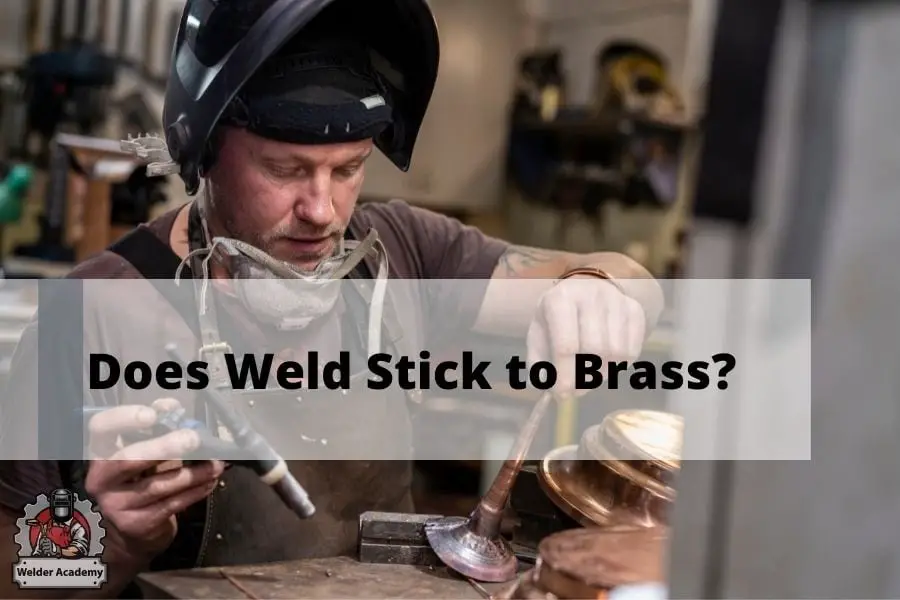If you are a professional welder, you might have noticed that joining brass is a bit difficult as copper and zinc have dissimilar melting points. You might be wondering, is it even possible?
Weld sticks to brass if you know the proper procedure and have some patience. First of all, you will need a specific “electrode type” called “Shielded ARC” to weld. Then, you will have to determine the exact composition of the brass. Finally, use a flat surface to weld the base metal as an uneven floor will make the joint weak.

I’ve talked about how weld can stick to brass, and now I’d like to provide some valuable insights into this topic. Here I will extensively discuss whether or not does weld stick to brass? For a better understanding of this topic, would be wise to read through the whole article. So, without further ado, let’s get right on with it.
Can Brass Be Welded?
Brass is a metal that has copper and zinc alloy and the ratio of zinc is around 20 percent to 45 percent. Now, since the alloy has two metals; and both of them have a different melting point, welding it becomes a challenge though not impossible.
Most of the brass metal out there will start melting at a temperature of 200 to 250 degrees Fahrenheit which is very high. Those who do not have enough experience in heavy welding, don’t usually work with such high temperatures. Honestly speaking, handling such heat can be very challenging especially if you are an amateur welder.
But that doesn’t mean welding brass is completely impossible. In fact, with the right process, two brass metals will stick strongly and can be used in various places where friction is minimal.
What Will You Need to Do Before Welding Brass?
Regular welding equipment will not work on brass at all. So, before starting to weld, you must make sure you have all the right items ready and have to perform a few tasks. All of the tasks I will talk about below are absolutely essential to weld brass. So do not skip out on any of them.
- Get Shielded ARC
Normal electrodes will not work efficiently when it comes to brass as it has two or several materials with various melting points. For getting the best result, you can use electrodes such as “shielded ARC”.
Shielded ARC-type electrodes include aluminum phosphorous bronze, silicon bronze, and aluminum bronze. Now, using them will reduce a lot of welding time and they will firmly stick with the brass metal. You will find all of these products on Amazon for a considerably cheap price.
- Know the Exact Composition of Brass
Now it should be very obvious that you will need to know the exact composition of the brass you are working with.
Usually, they have a zinc ratio of 20 percent to 45 percent. But, you will have to know the exact amount for achieving a strong joint.
- Avoid Very High Current
One of the most volatile metals out there is undoubtedly zinc. They can catch on fire in a matter of a few moments and if you are not careful enough, it can lead to a drastic accident.
That is why avoiding the use of very high currents is an absolute must. I know the fact that the use of high current can greatly accelerate the whole welding process, but when you are working with brass, use low current and be very wary while welding. Keeping a fire extinguisher in the welding room would be recommended.
- Perform the Welding Process on a Flat Surface
One of the most important facts about welding when it comes to brass is the surface. It should be completely flat and smooth. If you choose an uneven surface for welding brass, the end result will be a weaker joint.
Some of the best surfaces to weld brass include aluminum, cast iron, stainless steel, and carbon steel. I know, buying them will take a big bite on your wallet, but I can assure you, the end result will justify the investment.
Things You’ll Need to Keep in Mind While Welding Brass
It is an undeniable fact that welding brass is not an easy task. So, while performing, you must keep some facts in mind. First of all, most of the brass will make a wave pattern while welding whereas others might make a different sort of pattern. It is an important fact because you can determine whether the brass has properly melted or not.
The wavy pattern should be at least three times bigger than the used electrode’s width. It will ensure very good welding work. If the wave pattern is smaller, take the welding off the brass and restart the whole process.
Keeping a clean and dry environment will further ensure very firm welding work. As you might know, moisture and dirt can get mixed with the used electrodes and the final output will be affected. So, keep the welding room dry, and clean it up as much as you can. The brass metals will also need proper cleaning.
Now, most of the experts have agreed to the fact that “stick welding” is the perfect process to solder 2 brass metals. You can use stick welding both indoors and outdoors. The precision required for successfully soldering two brass metals can only be achieved by using the “stick welding” process.
Safety Precautions Of Welding Brass
Taking all the safety precautions before starting the welding process is absolutely essential. As I have mentioned earlier, welding brass is a very complicated process and a slight mishap will lead to a drastic accident. So maintain all the precautions mentioned below.
Wear the Safety Equipments
It should be very obvious that you will have to wear every safety wear properly before starting the welding process. While welding, a lot of flashes will occur and safety helmets will protect your eyes.
Moreover, it will protect your skin, hair, and face from spatter, sparks, and other dangerous detritus. Burning skin while welding is a very common mishap and it mainly occurs due to not wearing any helmet.
Now, using a flameproof apron is also essential. You don’t want your clothes burnt while welding brass. Many cheap aprons are available on Amazon. Finally, don’t forget about your feet. For avoiding accidents, I recommend you wear a high-top rubber boot.
Finally, never wear clothes that are slightly wet or sweaty. As I have mentioned earlier, moisture might react with the electrodes and the final output of the welding might get affected. Try to wear clothes that are made with quick-dry material.
Keep a Safe Distance and Never Look at the Spark
Some people get too comfortable after wearing all the safety equipment and they stand too close to the brass metals.
Always keep a safe distance before starting the welding process and never ever look at the spark with naked eyes. There are reports of people having serious vision problems just because of not wearing any safety helmets and looking at the spark directly.
Conclusion
As you can see, welding brass can be a bit challenging, but not impossible. In this article, I have extensively talked about whether or not does weld stick to brass. Hopefully, after reading the whole article, all of your confusion regarding this topic would be resolved.
Thanks for sticking with me till the end. And until next time, farewell.
